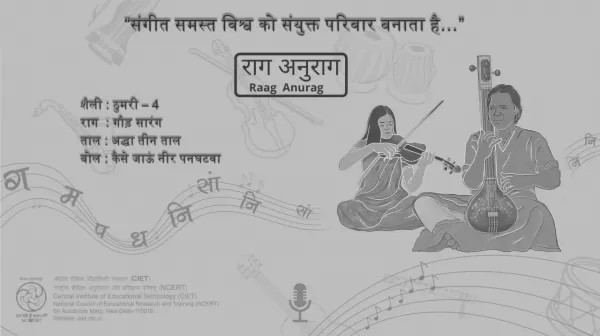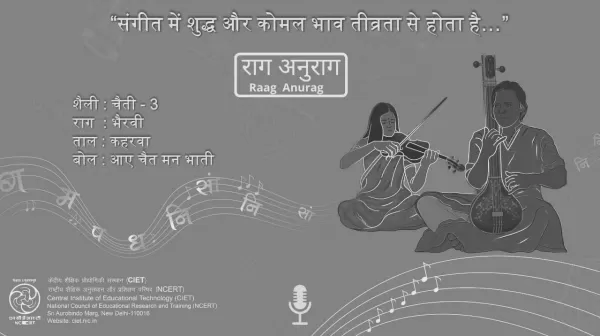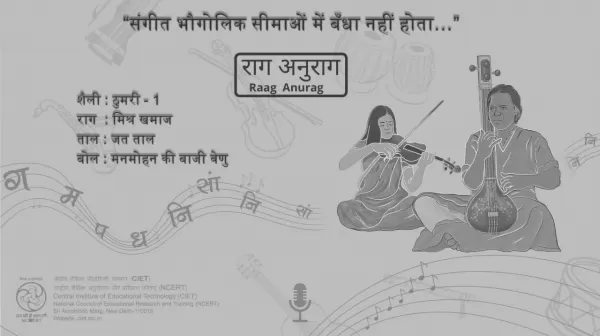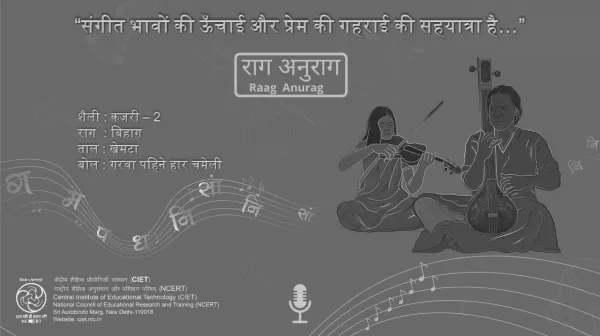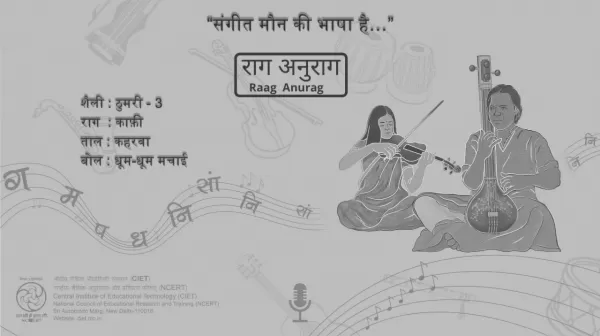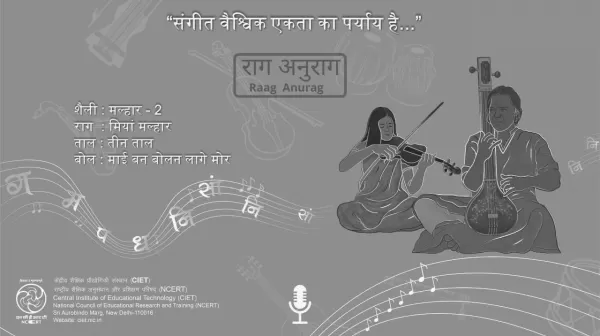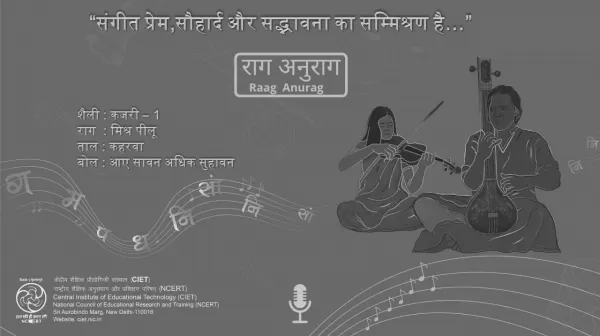Rag Anurag NCERT
Dadra 5 Rag Khamaj "Ab Mose Rar Kyon Machai"
Style of Dadra is very similar to Thumri but the tempo of Dadra is faster than Thumri thus it allows more freedom to be playful with musical note. The pivotal emotion is ornamentation. Dadra style is sung in Dadra taal itself. Dadra taal is fast and playful in nature. Songs based on dances and ornamentations are mainly sung in this Rag. Let’s have some short but basic information about Rag Khamaj before we listen to the Dadra based on Rag Des. The Wadi and samwadi swaras of Rag Khamaj is Gandhar and Nishad respectively.
Dadra-2 Rag Desi "Aisi Barsat Mein"
Style of Dadra is very similar to Thumri but the tempo of Dadra is faster than Thumri thus it allows more freedom to be playful with musical note. The pivotal emotion is ornamentation. Dadra style is sung in Dadra taal itself. Dadra taal is fast and playful in nature. Songs based on dances and ornamentations are mainly sung in this. Let’s have some short but basic information about Rag Des before we listen to the Dadra based on this Rag. Gandhar (Me) and Dhaiwat (La) are prohibited in the ascension of this Rag, both Ni (Ti) notes are applied and rest all nots are natural.
Dadra 3 Rag Kafi "Samujhai Batiyan Ek Na Mane"
Style of Dadra is very similar to Thumri but the tempo of Dadra is faster than Thumri thus it allows more freedom to be playful with musical note. The pivotal emotion is ornamentation. Dadra style is sung in Dadra taal itself. Dadra taal is fast and playful in nature. Songs based on dances and ornamentations are mainly sung in this. Let’s have some short but basic information about Rag Mishr Kafi before we listen to the Dadra based on this Rag. Rag Kafi originated from kafi That. Pancham, which is Pa (Soh) is amply used in this rag.
Dadra 4 Rag Hamir "Pyare Meri Galiyan Aaya Karo"
Style of Dadra is very similar to Thumri but the tempo of Dadra is faster than Thumri thus it allows more freedom to be playful with musical note. The pivotal emotion is ornamentation. Dadra style is sung in Dadra taal itself. Dadra taal is fast and playful in nature. Songs based on dances and ornamentations are mainly sung in this Rag. Let’s have some short but basic information about Rag Hamir before we listen to the Dadra based on this Rag. The very inception of Rag Hamir is from Kalyan That.
Dadra -1 Rag Bhairavi "Banka Bana Raghuraiyya"
Style of Dadra is very similar to Thumri but the tempo of Dadra is faster than Thumri thus it allows more freedom to be playful with musical note. The pivotal emotion is ornamentation. Dadra style is sung in Dadra taal itself. Dadra taal is fast and playful in nature. Songs based on dances and ornamentations are mainly sung in this. Let’s know a little bit about Rag Bhairavi before listening to Dadra based on it. Rag Bhairavi has incepted from Bhairavi thhat (Family). In this Rag, Re (Re), Ga (Me), Dha (La) and Ni (Ti) are used as sharp denoted here with #. It is Sampurna in nature.
Chaiti-4 Rag Mishra "Peelu Raja Gaye Kaun Des"
Chaiti is semi classical style of Hindustani music. It has derived from the folk music of the Indian state of Uttar Pradesh and based on chaitra month i.e. the mid-March of English calendar. Semi-classical “Bandish” (Determined melody structure) are sung in it. Love, beauty of nature and the Holi festival (the Indian festival of colors) are the prominent themes of Chaiti. Chaitra month is also considered as the birth month of Shri Rama and thus, the scriptural descriptions of the childhood of Shri Rama are included in the singing structure of Chaiti.
Chaiti-3 Rag Bhairavi "Aae Chait Manbhati"
Chaiti is semi classical style of Hindustani music. It has derived from the folk music of the Indian state of Uttar Pradesh and based on chaitra month i.e. the mid-March of English calendar. Semi-classical “Bandish” (Determined melody structure) are sung in it. Love, beauty of nature and the Holi festival (the Indian festival of colors) are the prominent themes of Chaiti. Chaitra month is also considered as the birth month of Shri Rama and thus, the scriptural descriptions of the childhood of Shri Rama are included in the singing structure of Chaiti.
Chaiti 2 Rag Mishra Khamaj "Baaje Re Abadh Main Badhiya"
Chaiti is semi classical style of Hindustani music. It has derived from the folk music of the Indian state of Uttar Pradesh and based on chaitra month i.e. the mid-March of English calendar. Semi-classical “Bandish” (Determined melody structure) are sung in it. Love, beauty of nature and the Holi festival (the Indian festival of colors) are the prominent themes of Chaiti. Chaitra month is also considered as the birth month of Shri Rama and thus, the scriptural descriptions of the childhood of Shri Rama are included in the singing structure of Chaiti.
Chaiti -1 Rag Des "Jhukvan Pawan Jhakore"
Chaiti is semi classical style of Hindustani music. It has derived from the folk music of the Indian state of Uttar Pradesh and based on chaitra month i.e. the mid-March of English calendar. Semi-classical “Bandish” (Determined melody structure) are sung in it. Love, beauty of nature and the Holi festival (the Indian festival of colors) are the prominent themes of Chaiti. Chaitra month is also considered as the birth month of Shri Rama and thus, the scriptural descriptions of the childhood of Shri Rama are included in the singing structure of Chaiti.
Khemta Rag Mishra Khamaj "Jahan Bole Panchhi More"
Style of Khemta resambles with Thumri but the tempo of Khemta is faster than Dadra and so, it permits the artists to be more playful. It is sung in Khemta Taal mainly with central idea of ornamentation. Let us know some salient features of Rag Khamaj before we listen to the Khemta based on this Rag. The Wadi and samwadi swaras of this Rag are Gandhar and Nishad (Me and (Ti). It is sung at the 2nd watch of the night. Music is not confined to the geographical boundaries. Indian Ragas can be played not only in Indian musical instruments but in western musical instruments as well.

